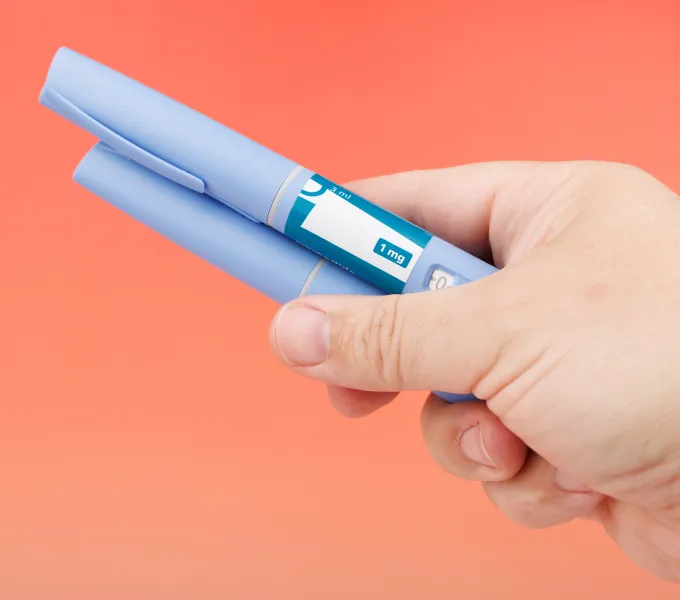
This is How You Use a Pelvic Floor Wand
Muscle knots, tight muscles, and scar tissue in your pelvic floor and vulva are all common causes of pelvic pain, including painful sex. These “tissue issues” create pain and sexual dysfunction in many ways, including restricting blood flow to the vulvar and vaginal tissues, irritating the nerves in the pelvic floor muscles, and limiting muscle and tissue flexibility.
If any of this sounds like you, pelvic floor physical therapy is the place to start. A PT can assess your symptoms and create a treatment plan for resolving your pain. That plan may include manual therapy techniques that restore flexibility and blood flow to muscles throughout your pelvic floor.
PTs often recommend that patients continue manual therapy on their own, using a pelvic floor wand. A wand has a long and curved shape with a thin, finger-like tip that can help you reproduce your pelvic physical therapist’s treatment between sessions.
If you're considering using a wand, it's important to understand how to use it properly, so that you can feel confident managing your symptoms — and avoid techniques that could make your symptoms worse. To help get you started, we put together this step-by-step user's guide.
In the market for a wand? Check out The Best Pelvic Floor Wands According to a Pelvic Floor PT for some PT-approved options.
Getting ready to use a pelvic floor wand
Clean your pelvic floor wand
Always start and end your pelvic wand session by properly cleaning it. This will help make sure your wand lasts, and also prevent any chance of developing a vaginal infection. Using warm, running water; and mild, unscented soap; thoroughly clean your entire wand before and after each use. Dry with a paper towel and store in a clean, dry place.
Recline and relax
Lay back on your bed with knees bent. Use plenty of pillows to support your head, upper body, and knees. You want enough pillows behind your back that you don't feel you are having to crunch up to use the wand.
Try letting your legs fall out into a butterfly position to easily access the vaginal entrance. You can also try lying on your side with a pillow between your knees, and insert the wand from behind if this is more comfortable.

Add lubricant
Generously cover the tip and sides of the wand, with a wand-friendly lube. We recommend a water-based, glycerin-free option, such as Slippery Stuff, or H2O - Sliquid Naturals.
If you are using a silicon pelvic wand, use a water-based lubricant and not a silicone-based one, as this may cause the material to degrade. For more lube options, check out this blog.
How to use a pelvic floor wand to heal your pelvic floor
1. Insert the wand
Place the wand at your vaginal entrance so that the wand can be inserted straight. If using the wand to soften perineal scar tissue (see below), insert the tip to rest just inside of the vaginal opening. For deeper muscle treatment, fully insert the first segment of the wand to the beginning of where the wand begins to curve.
2. Soften any existing scar tissue
If you've had a baby and experienced any perineal tearing, you can use your pelvic wand to help soften or 'mobilize' your perineal scar, which can help prevent pain and tension around your scar. (Before you start, make sure you've been cleared by your physician for scar tissue mobilization.)
- Insert the tip of the wand to rest just inside of the vaginal opening, at the location of your scar.
- Apply gentle pressure down onto the scar, stretching open the tissues that surround the vaginal entrance. On a pain scale of 0 to 10, the stretch sensation should not exceed a 4 or 5/10.
- Hold this stretch for at least a minute (or as directed by your physical therapist), depending on your needs.
- If your scar is sensitive, move the wand to the right or left of the scar, and stretch the surrounding tissues instead. Move towards the scar as you progress and feel less sensitivity over time.
3. Find your muscles
If you aren’t very familiar with pelvic anatomy, your pelvic floor muscles might be hard to locate, at first. To help, think about your pelvic floor muscles in terms of a clock, with 6 o’clock straight down towards your perineal body and anal opening, and 3 and 9 o’clock, out toward your thighs. Avoid applying any stretching or pressure with your pelvic wand in the 12 o’clock position (straight up) as this is where your urethra is located.

Once oriented, rotate the handle of the wand towards the side to be treated, while keeping the inserted end straight. Once turned, angle the wand to direct the tip down into your muscles until a tender spot is located (the handle and the tip of the wand will move in opposite directions).
4. Add pressure and stretch
Place a constant, gentle, very light pressure on the tender point with the wand for several seconds. You may feel the muscle twitch as the spasm is released, as this is a normal response. Gradually increase your pressure as tolerated, but remember the discomfort caused by the stretch should never increase beyond a 4-5/10 on the pain scale.
5. Practice mindfulness
As you use the wand, be mindful of where, or if, your body is holding tension. Slowly breath in and out, consciously release any stored tension in your body, and visualize your muscles softening to the pressure from the wand. Being mindful during pelvic wand use can help enhance the physical benefits of the muscle release.
6. Continue finding tender points
As the tender point softens, you may reduce your pressure and move the wand to the next tender point “around the clock” on that same side. When changing sides, straighten the tip of the wand back to the center of your vagina, and then rotate the handle to the other side, and repeat the above process.
Use your pelvic wand to gently stretch all of the areas of tension throughout your pelvic floor, and/or as specifically directed by your physical therapist. Just remember, do not use the wand for more than 10 minutes, once a day to avoid tissue irritation. Be careful to not increase your pain. Your pain should reduce with use.
Tips for pelvic floor wand success
Straight from the box, your pelvic wand can feel a tad intimidating. But with individualized guidance from a pelvic health physical therapist, and being mindful of the cleaning and basic use instructions noted above, the pelvic wand can be a really safe and effective tool for self-treating some of the most common causes of pelvic pain, and painful vaginal or anal penetration.
For a little extra know-how, check out the following bonus tips to help you feel even more confident and in control of your pelvic health when using your pelvic wand:
- Use adequate lube. For specific lube recommendations, refer back to Step 2, but we recommend you don’t shy away from the lube. Lubricant will help ease any tenderness you may experience during insertion or other movements with the wand.
- Experiment with different body positions. We have recommended two helpful positions above, but there is not one “best” position to be in. Shift your leg and truck into different positions, or try different angles of insertion to find the best combination for your body.
- Switch up your guiding hand. When working on the left side of your body, it may be easier to use the right hand with the wand, and vice versa.
- Watch for symptom changes. While using the wand, your symptoms should stay at around the 4/10 level — aka it’s feeling a tad uncomfortable, and it feels like you are on a spot that needs attention, but it’s NOT painful. If discomfort increases and/or turns into pain as you are using the wand, this would be a good place to stop. Come back to it at another time, and make sure to reach out to your pelvic health physical therapist to let them know!
- Avoid pressure on your nerves. If pressure causes "nervy" pain or sensation — this may feel like a sharp or shooting pain — move the wand slightly away from this point as you may be pushing on a nerve.
- Practice mindfulness. Pay attention to your body and how it is responding while using the pelvic floor wand. Mindfulness strategies can help you stay in control of your body’s responses, and complement your other pain management strategies. Two recommended strategies to improve your mindfulness are: diaphragmatic breathing and pelvic floor meditation.
Remember: You are in control of the pelvic wand. Go at your own pace and progress when you are ready.
Don't wait to see a pelvic floor PT
Before you get started with your pelvic wand, we want to recommend (and know it’s best) for you to see a pelvic PT if you have pelvic pain and pain with sex. Your Origin PT will fully examine your symptoms and ensure your pain is coming from your pelvic floor, and not from a medical cause. They'll also give you personalized treatment and coach you on how to use a pelvic wand to get relief, which is important when it comes to successfully using this tool to help heal your pelvic pain.
The causes of pelvic pain and pain with sex can be complex, and often involve a history of injury or trauma. Using therapy tools such as the pelvic wand without guidance from a properly trained healthcare professional may leave you at risk for increasing your pain, or provoking an unexpected trauma response. But with the proper guidance, pelvic wands are a helpful and safe tool that can help you achieve your pelvic health goals.
We understand that there are many hurdles to getting the healthcare you need to feel good in your body, which is why we encourage you to start by scheduling an evaluation with one of our virtual physical therapists. You can Zoom with an Origin PT from anywhere in the country, and because we accept most major commercial insurances (and have low cash rates for those without an insurance option) seeing a pelvic health physical therapist is more affordable than ever before.
For more information on how pain with sex can impact your body check out this blog on trauma and pain with sex, and this one on how our bodies can respond to trauma.




